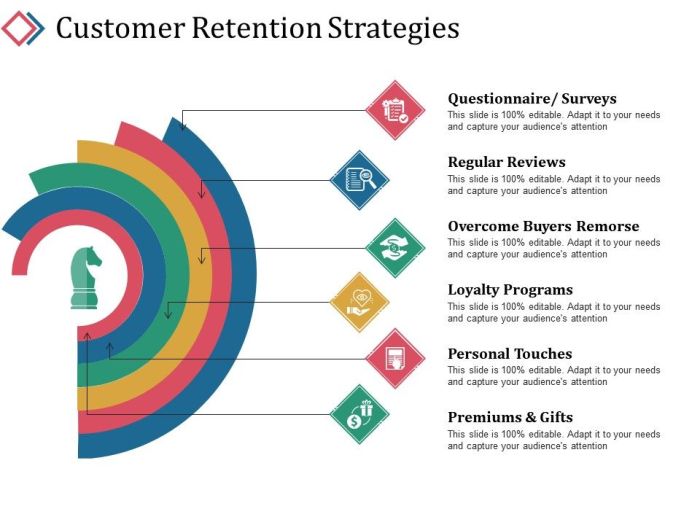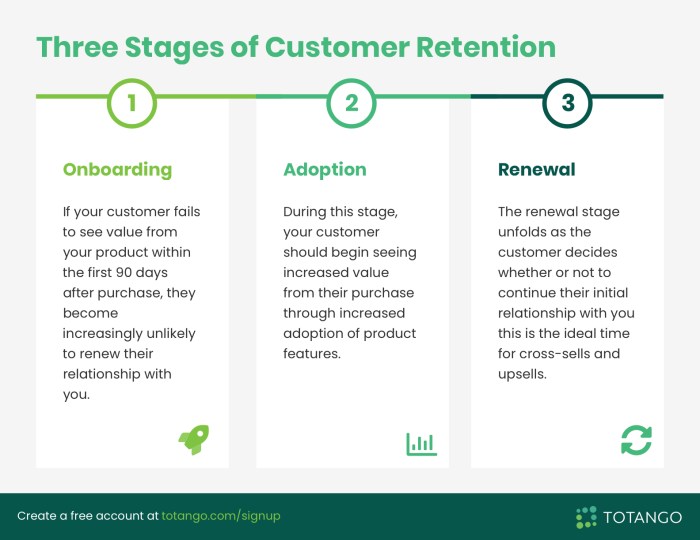Developing a Customer Retention Plan dives into the key strategies essential for businesses looking to retain their customer base. From understanding customer behavior to creating loyalty programs and effective communication strategies, this guide will explore the ins and outs of keeping customers satisfied and coming back for more.
Importance of Customer Retention Plan

Having a customer retention plan is crucial for businesses to ensure long-term success and sustainability. By focusing on retaining existing customers, companies can build strong relationships, increase customer loyalty, and drive revenue growth.
Examples of Successful Companies
- Amazon: Amazon’s Prime membership program offers exclusive benefits and perks to retain customers and encourage repeat purchases.
- Apple: Apple’s ecosystem of products and services creates a seamless customer experience, leading to high retention rates.
- Starbucks: Starbucks’ loyalty program rewards customers for frequent visits, leading to increased customer retention and lifetime value.
Benefits of Customer Retention
By focusing on customer retention rather than solely acquiring new customers, businesses can enjoy several benefits:
- Increased Revenue: Existing customers are more likely to make repeat purchases and spend more than new customers.
- Cost Savings: It is more cost-effective to retain customers than to acquire new ones, as the marketing and advertising expenses are lower.
- Customer Loyalty: Building strong relationships with existing customers leads to higher levels of loyalty and advocacy for the brand.
- Competitive Advantage: Companies with high customer retention rates have a competitive edge over their rivals in the market.
Understanding Customer Behavior
Understanding customer behavior is crucial in developing a customer retention plan as it helps businesses anticipate the needs and preferences of their customers. By analyzing how customers interact with a brand, companies can tailor their strategies to enhance customer satisfaction and loyalty.
Utilizing Data Analytics
Data analytics plays a key role in analyzing customer preferences and patterns. By collecting and analyzing data on customer interactions, purchases, and feedback, businesses can gain valuable insights into what drives customer behavior. This information can then be used to create personalized experiences and targeted marketing campaigns to retain customers.
- Data analytics can help identify trends and patterns in customer behavior, allowing businesses to anticipate future needs and preferences.
- By segmenting customers based on their behavior, businesses can create personalized marketing campaigns that resonate with different customer segments.
- Tracking customer engagement metrics can help businesses understand which strategies are most effective in retaining customers and driving loyalty.
The Significance of Personalization
Personalization is a key component of customer retention as it creates a unique and tailored experience for each customer. By personalizing interactions, products, and services, businesses can make customers feel valued and understood, leading to increased loyalty and retention rates.
- Personalization can help businesses build stronger relationships with customers, increasing trust and loyalty over time.
- Customizing offers and recommendations based on customer preferences can enhance the overall customer experience and drive repeat purchases.
- By using personalization techniques, businesses can differentiate themselves from competitors and stand out in a crowded marketplace.
Creating Customer Loyalty Programs

To enhance customer retention, businesses can implement various types of customer loyalty programs that incentivize repeat purchases and foster long-term relationships with their customers.
Points-Based Loyalty Programs
- Reward customers with points for each purchase, which can be redeemed for discounts, free products, or exclusive perks.
- Examples: Starbucks Rewards, Sephora Beauty Insider, and Amazon Prime.
- Impact: Increases customer engagement and encourages repeat purchases to earn more points.
Tiered Loyalty Programs
- Offer different levels of benefits based on customer loyalty, such as VIP access, personalized services, and special promotions.
- Examples: Marriott Bonvoy, Delta SkyMiles, and American Express Membership Rewards.
- Impact: Motivates customers to reach higher tiers by providing exclusive rewards and recognition.
Paid Loyalty Programs
- Charge customers a fee to join a loyalty program that offers premium perks, early access to products, and enhanced customer service.
- Examples: Costco Executive Membership, Amazon Prime, and Sephora Flash.
- Impact: Generates additional revenue while strengthening customer loyalty through exclusive benefits.
Gamified Loyalty Programs
- Integrate game-like elements such as challenges, points, and rewards to make the loyalty program more interactive and engaging.
- Examples: McDonald’s Monopoly, Nike Run Club, and Starbucks Bonus Star challenges.
- Impact: Increases customer participation and enjoyment, leading to higher retention rates and brand loyalty.
Communication Strategies
Effective communication is key to maintaining a strong relationship with customers. By keeping the lines of communication open and engaging, businesses can build trust and loyalty with their customer base.
Role of Omnichannel Communication
Omnichannel communication plays a crucial role in customer retention by providing a seamless experience across multiple channels. This allows customers to interact with the brand in a way that is convenient for them, whether it’s through email, social media, phone, or in-person.
- Utilize a variety of communication channels to reach customers where they are most active.
- Ensure consistent messaging and branding across all channels for a cohesive customer experience.
- Track customer interactions across different channels to better understand their preferences and behavior.
- Personalize communication based on the customer’s channel of choice to enhance engagement and satisfaction.
By implementing an omnichannel communication strategy, businesses can create a more personalized and convenient experience for their customers, ultimately leading to increased loyalty and retention.
Personalizing Communication
Personalizing communication is essential for increasing customer loyalty. By tailoring messages and interactions to individual preferences and behaviors, businesses can create a more meaningful connection with their customers.
- Collect data on customer preferences, purchase history, and interactions to better understand their needs.
- Segment customers based on their preferences and behaviors to deliver targeted and relevant communication.
- Use customer names and personalized recommendations to make communication more engaging and personal.
- Solicit feedback and reviews from customers to show that their opinions and experiences are valued.
Personalizing communication shows customers that they are more than just a number, building a sense of loyalty and connection that can lead to long-term relationships.
Monitoring and Evaluation: Developing A Customer Retention Plan
Monitoring and evaluating key metrics is crucial to determine the effectiveness of a customer retention plan. By tracking specific indicators, businesses can identify areas of improvement and make informed decisions to enhance customer loyalty.
Key Performance Indicators (KPIs), Developing a Customer Retention Plan
Key performance indicators serve as benchmarks to assess the success of customer retention efforts. Some examples of KPIs that can be used include:
- Customer Churn Rate: Measure the percentage of customers who stop using your services or products over a given period.
- Customer Lifetime Value (CLV): Calculate the total revenue a customer generates throughout their relationship with your company.
- Net Promoter Score (NPS): Determine customer satisfaction and loyalty based on the likelihood of customers to recommend your business to others.
- Repeat Purchase Rate: Track the percentage of customers who make multiple purchases within a specific timeframe.
Feedback Mechanisms for Continuous Improvement
Feedback mechanisms play a vital role in refining the customer retention strategy. By collecting feedback from customers through surveys, reviews, and direct communication, businesses can gain valuable insights into customer preferences and areas needing improvement. This information can be used to tailor retention initiatives and create a more personalized customer experience, ultimately increasing loyalty and satisfaction.
